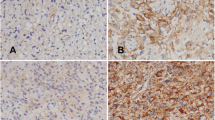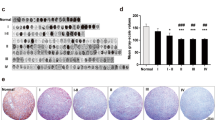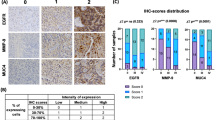Abstract
Epithelial cell adhesion molecule (EpCAM) is overexpressed in various neoplasms as a tumor-associated antigen and absent in natural brain. However, little is known about EpCAM’s expression in gliomas. To investigate the expression of EpCAM in gliomas and understand the correlation of EpCAM expression with malignancy, proliferation, angiogenesis, and prognosis, we studied the expression of EpCAM in 98 glioma samples by immunohistochemistry and by western blotting (N = 12). Correlative analysis of EpCAM overexpression with microvessel density (MVD), Ki-67 expression, age, and gender were made. Survival data was analyzed with Kaplan–Meier method and Cox Proportional Hazard Model. Immunohistochemistry results showed EpCAM was widely expressed in glioma (90.8 %). The overexpression rate of WHO grade IV gliomas was significantly higher EpCAM overexpression correlated significantly with Ki-67 expression and MVD. Western blot analysis also revealed a stepwise increase in EpCAM expression from WHO II to IV glioma. The overall survival of WHO III and IV glioma patients with EpCAM overexpression was obviously lower than that without EpCAM overexpression. EpCAM overexpression was an independent prognostic factor for overall survival in glioma patients. This study firstly shows that EpCAM overexpression correlates significantly with malignancy (WHO grades), proliferation (Ki67), angiogenesis (MVD), and prognosis in gliomas. EpCAM may participate in tumorgenesis of gliomas.



Similar content being viewed by others
References
Ohgaki H (2009) Epidemiology of brain tumors. Methods Mol Biol 472:323–342. doi:10.1007/978-1-60327-492-0_14
Louis DN, Ohgaki H, Wiestler OD, Cavenee WK (2007) World Health Organization Classification of Tumours: Pathology and genetics of tumours of the nervous system. International Agency for Research on Cancer (IARC), Lyon
Wen PY, Kesari S (2008) Malignant gliomas in adults. N Engl J Med 359:492–507. doi:10.1056/NEJMra0708126
Stupp R, Mason WP, van den Bent MJ et al (2005) Radiotherapy plus concomitant and adjuvant temozolomide for glioblastoma. N Engl J Med 352:987–996
Rousseau A, Mokhtari K, Duyckaerts C (2008) The 2007 WHO classification of tumors of the central nervous system—what has changed? Curr Opin Neuro 21(6):720–727. doi:10.1097/WCO.0b013e328312c3a7
Labussiere M, Wang XW, Idbaih A, Ducray F, Sanson M (2010) Prognostic markers in gliomas. Future Oncol 6(5):733–739. doi:10.2217/fon.10.25
Phillips HS, Kharbanda S, Chen R et al (2006) Molecular subclasses of high-grade glioma predict prognosis, delineate a pattern of disease progression, and resemble stages in neurogenesis. Cancer Cell 9(3):157–173. doi:10.1016/j.ccr.2006.02.019
Carpenter G, Red Brewer M (2009) EpCAM: another surface-to-nucleus missile. Cancer Cell 15(3):165–166. doi:10.1016/j.ccr.2009.02.005
Gires O, Klein CA, Baeuerle PA (2009) On the abundance of EpCAM on cancer stem cells. Nat Rev Cancer 9:143. doi:10.1038/nrc2499-c1
Schnell U, Kuipers J, Giepmans BN (2013) EpCAM proteolysis: new fragments with distinct functions? Biosci Rep 33(2):e00030. doi:10.1042/BSR20120128
Herlyn D, Herlyn M, Steplewski Z, Koprowski H (1979) Monoclonal antibodies in cell-mediated cytotoxicity against human melanoma and colorectal carcinoma. Eur J Immunol 9:657–659. doi:10.1002/eji.1830090817
Baeuerle PA, Gires O (2007) EpCAM (CD326) finding its role in cancer. Br J Cancer 96:417–423. doi:10.1038/sj.bjc.6603494
van der Gun BT, Melchers LJ, Ruiters MH, de Leij LF, McLaughlin PM, Rots MG (2010) EpCAM in carcinogenesis: the good, the bad or the ugly. Carcinogenesis 31(11):1913–1921. doi:10.1093/carcin/bgq187
Patriarca C, Macchi RM, Marschner AK, Mellstedt H (2012) Epithelial cell adhesion molecule expression (CD326) in cancer: a short review. Cancer Treat Rev 38(1):68–75. doi:10.1016/j.ctrv.2011.04.002
Osta WA, Chen Y, Mikhitarian K et al (2004) EpCAM is overexpressed in breast cancer and is a potential target for breast cancer gene therapy. Cancer Res 64:5818–5824. doi:10.1158/0008-5472.CAN-04-0754
Münz M, Kieu C, Mack B, Schmitt B, Zeidler R, Gires O (2004) The carcinoma-associated antigen EpCAM upregulates c-myc and induces cell proliferation. Oncogene 23:5748–5758. doi:10.1038/sj.onc.1207610
Gastl G, Spizzo G, Obrist P, Dünser M, Mikuz G (2000) EpCAM overexpression in breast cancer as a predictor of survival. Lancet 356:1981–1982. doi:10.1016/S0140-6736(00)03312-2
Spizzo G, Fong D, Wurm M et al (2011) EpCAM expression in primary tumour tissues and metastases: an immunohistochemical analysis. J Clin Pathol 64(5):415–420. doi:10.1136/jcp.2011.090274
Yanamoto S, Kawasaki G, Yoshitomi I, Iwamoto T, Hirata K, Mizuno A (2007) Clinicopathologic significance of EpCAM expression in squamous cell carcinoma of the tongue and its possibility as a potential target for tongue cancer gene therapy. Oral Oncol 43:869–877. doi:10.1016/j.oraloncology.2006.10.010
Yamashita T, Budhu A, Forgues M, Wang XW (2007) Activation of Hepatic Stem Cell Marker EpCAM by Wnt Signaling in Hepatocellular Carcinoma. Cancer Res 67(22):10831–10839. doi:10.1158/0008-5472
Imrich S, Hachmeister M, Gires O (2012) EpCAM and its potential role in tumor-initiating cells. Cell Adh Migr 6(1):30–38. doi:10.4161/cam.18953
Maetzel D, Denzel S, Mack B et al (2009) Nuclear signalling by tumour-associated antigen EpCAM. Nat Cell Biol 11(2):162–171. doi:10.1038/ncb1824
Went PT, Lugli A, Meier S et al (2004) Frequent EpCam protein expression in human carcinomas. Hum Pathol 35(1):122–128. doi:10.1016/j.humpath.2003.08.026
Subirá D, Serrano C, Castañón S et al (2012) Role of flow cytometry immunophenotyping in the diagnosis of leptomeningeal carcinomatosis. Neuro Oncol 14(1):43–52. doi:10.1093/neuonc/nor172
Kurtz JE, Dufour P (2010) Adecatumumab: an anti-EpCAM monoclonal antibody, from the bench to the bedside. Expert Opin Biol Ther 10(6):951–958. doi:10.1517/14712598.2010.482098
Chaudhry IH, O’Donovan DG, Brenchley PE, Reid H, Roberts IS (2001) Vascular endothelial growth factor expression correlates with tumour grade and vascularity in gliomas. Histopathology 39:409–415. doi:10.1046/j.1365-2559.2001.01230.x
Rahmah NN, Sakai K, Sano K, Hongo K (2012) Expression of RECK in endothelial cells of glioma: comparison with CD34 and VEGF expressions. J Neurooncol 107(3):559–564. doi:10.1007/s11060-011-0778-z
Netto GC, Bleil CB, Hilbig A, Coutinho LM (2008) Immunohistochemical evaluation of the microvascular density through the expression of TGF-beta (CD 105/endoglin) and CD 34 receptors and expression of the vascular endothelial growth factor (VEGF) in oligodendrogliomas. Neuropathology 28:17–23. doi:10.1111/j.1440-1789.2007.00825.x
Vermeulen PB, Gasparini G, Fox SB et al (1996) Quantification of angiogenesis in solid human tumours: an international consensus on the methodology and criteria of evaluation. Eur J Cancer 32A:2474–2484
Deb P, Boruah D, Dutta V (2012) Morphometric study of microvessels in primary CNS tumors and its correlation with tumor types and grade. Microvasc Res 84(1):34–43. doi:10.1016/j.mvr.2012.03.004
Varga Z, Diebold J, Dommann-Scherrer C et al (2012) How reliable is Ki-67 immunohistochemistry in grade 2 breast carcinomas? A QA study of the Swiss Working Group of Breast-and Gynecopathologists. PLoS One 7:e37379. doi:10.1371/journal.pone.0037379
Scholzen T, Gerdes J (2000) The Ki-67 protein: from the known and the unknown. J Cell Physiol 182:311–322. doi:10.1002/(SICI)1097-4652(200003)182:3<311:AID-JCP1>3.0.CO;2-9
Hou XZ, Liu W, Fan HT et al (2010) Expression of hepatocyte growth factor and its receptor c-Met in human pituitary adenomas. Neuro Oncol 12(8):799–803. doi:10.1093/neuonc/noq024
Pang B, Fan H, Zhang IY et al (2012) HMGA1 expression in human gliomas and its correlation with tumor proliferation, invasion and angiogenesis. J Neurooncol 106(3):543–549. doi:10.1007/s11060-011-0710-6
Fong D, Steurer M, Obrist P et al (2008) Ep-CAM expression in pancreatic and ampullary carcinomas: frequency and prognostic relevance. J Clin Pathol 61(1):31–35. doi:10.1136/jcp.2006.037333
Varga Meri, Obrist Peter, Schneeberger Stephan et al (2004) Overexpression of epithelial cell adhesion molecule antigen in gallbladder carcinoma is an independent marker for poor survival. Clin Cancer Res 10:3131–3136. doi:10.1158/1078-0432
Spizzo G, Went P, Dirnhofer S, Obrist P et al (2006) Overexpression of epithelial cell adhesion molecule (Ep-CAM) is an independent prognostic marker for reduced survival of patients with epithelial ovarian cancer. Gynecol Oncol 103(2):483–488. doi:10.1016/j.ygyno.2006.03.035
McGirt MJ, Chaichana KL, Gathinji M et al (2009) Independent association of extent of resection with survival in patients with malignant brain astrocytoma. J Neurosurg 110(1):156–162. doi:10.3171/2008.4.17536
Acknowledgments
This study was supported by the National Natural Science Foundation of China (Grant no. 81171062). The authors thank the patients who contributed to this research.
Conflict of interest
All authors declare that they have no conflict of interest.
Ethical standards
All the experiments in this article comply with the current laws of China.
Author information
Authors and Affiliations
Corresponding authors
Rights and permissions
About this article
Cite this article
Chen, X., Ma, WY., Xu, SC. et al. The overexpression of Epithelial cell adhesion molecule (EpCAM) in glioma. J Neurooncol 119, 39–47 (2014). https://doi.org/10.1007/s11060-014-1459-5
Received:
Accepted:
Published:
Issue Date:
DOI: https://doi.org/10.1007/s11060-014-1459-5




